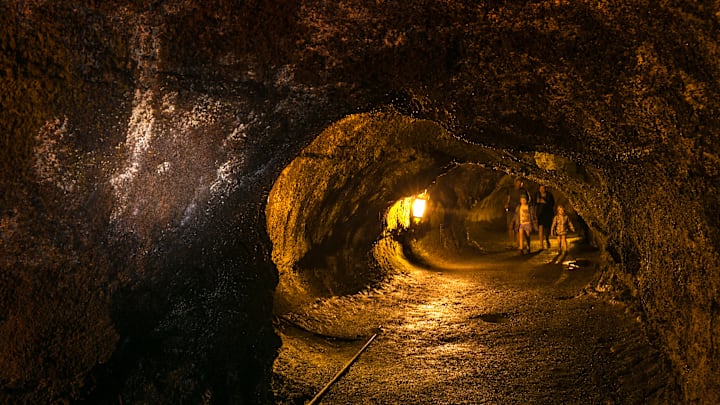Caves and volcanoes don’t often go hand-in-hand in our imaginations. When we think of caves, we imagine still, dark spaces underground. Volcanoes, on the other hand, loom above us with a threatening explosive power. But in fact, the second most common type of cave in the world is made from the power of volcanoes. They are lava tubes.
Lava tubes are cylindrical caves made from cooled, hardened lava. Inside, you won’t find colorful limestone formations. Rather, you’re faced with inky black igneous rock making up the floor, walls, and ceiling. Grooves on the walls show former lava flow levels, and lavacicles, stalactites formed from lava cooling as it drips from the ceiling, often hang above. Creatures such as bats, spiders, and various insects often make their homes inside.
But how does a tube of rock come from a stream of lava? Because lava is a fluid, it flows in the same way a river does. But the outside edges of that lava stream cool much faster than the inside because of its exposure to the outside air. So, just as a pond freezes over in the cold, the edges of the lava stream begin to harden, eventually forming a shell and encasing the flowing lava. The lava inside is then insulated and becomes superheated, causing it to erode the surface underneath. This erosion creates the lava tube’s circular shape. When the eruption is over, the lava slowly drains from the tube. It can take more than a year for the cave to cool completely, but when it does, animals start to move in.
Of course, not all lava tubes are safe for human exploration. Many still have active lava flows within, holding incredible (and incredibly dangerous) heat. The lava within active lava tubes in Hawai’i, for example, is around 2200° F (or 1250° C). People are therefore only allowed inside lava tubes that are completely drained and cooled. The National Park Service maintains many of these lava tubes, so it’s generally a safe experience, but as with any natural area, visitation is at your own risk. Some potential hazards are rockfall and low to no lighting; but the biggest problem you’ll likely face when visiting is tripping. Space can also get pretty tight in some of the tubes, so if you’re claustrophobic, it might not be the venture for you.
Because of their volcanic nature, lava tubes are most commonly found in regions with a lot of geothermal activity. Hawai’i, in particular, has countless lava tubes because the islands themselves were formed from volcanic forces. This also means they have some of the most spectacular lava tubes around. But there are also lava tubes along the west coast of the United States, such as at California’s Lava Beds National Monument and Lassen Volcanic National Park or Craters of the Moon National Monument and Preserve in Idaho. In fact, they’re on almost every continent; you can visit lava tubes in Iceland, South Korea, Kenya, and Australia. If you’re able to arrange some extraterrestrial travel, they’re also on the moon and on Mars.
Pretty much anywhere you can find volcanoes, you can find lava tubes. Chances are you can even take a peek inside the earthbound ones. Just don’t forget your headlamp.
